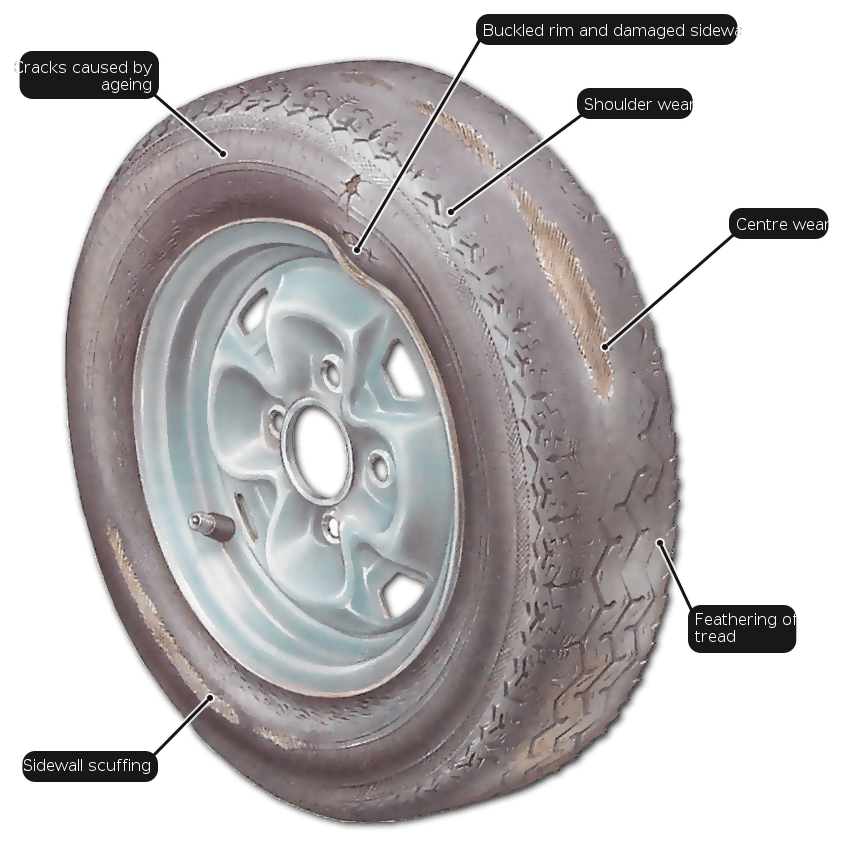How to check the wheel and tire is damaged
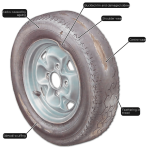
When the car tires will be under great pressure. Tread only four relatively small areas in contact with the road. They is bearing the weight of the total weight of the car and road transmission drive and accelerate its power, make it more than the surface of the encounter and gradient of many changes.
They must also transmit the forces generated by braking and cornering.
Because they are in constant contact with surfaces that are frequently abrasive, damaged and even broken, tyres are more liable to wear and physical damage than any other car component.
To be on the safe side, please check their wheels. At least once every two weeks to do, and before any long or high speed travel. Serious wear and tear or damage to the tire is illegal, potentially fatal: they can take your license, or even your life.
It is better to look over the tyres and wheels while they are on the car than not to inspect them at all. But for a thorough examination of the inside walls, the wheels should be taken off about once a year (See Checking, removing and refitting road wheels).
Inspecting tyre treads and sidewalls
The tread is the obvious place to start looking for tyre damage. Begin by inspecting carefully the whole circumference for abnormal wear and flaws in the pattern.
Abnormal widening of the grooves, or the spaces between tread blocks, usually means that the tyres are ageing.
If a series of cracks is evident, replace the tyre – even though there may still be 1-3 mm of tread left.
Pay special attention to the small groove and incision – known as “groove pattern”. Looking for sharp flint and stones, or nails and tack, this is often the reason, and can lead to internal damage the embedded pieces. The debris can use screwdriver to shovel out. But remove it could lead to a tire with a slow puncture.
Check for loss of pressure, and if it occurs have a tyre-repair shop take the tyre off the rim, inspect it, and make a permanent repair.
Look also for ‘flats’ in the tread, worn perhaps by severe emergency braking – when the tyre of a locked wheel slides on the road, wearing off the rubber and generating a lot of heat.
Abnormally severe wear at the tread shoulders or uneven tread wear are warning signs that should never be ignored.
They could be the result of more fundamental problems perhaps in the tracking or suspension and could soon lead to failure at speed.
The tire uplift is a sign of tire body damage. Before through the wire, the speed of the tires is not safe. Sometimes damage may not be visible, so if you have a doubt after may run into the side of the road – but don’t see any external evidence, request professional tire fitter remove the suspect tyre and check.
Often, fractures are visible inside before they become obvious outside. Any break in the carcass construction means replacing the tyre. It cannot be repaired safely.
Checking the tread depth
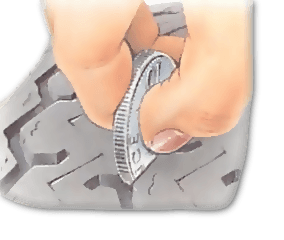
Less than 1 mm tires tire tread is illegal in the UK. Tread must be at least 1 mm deep, more than 75% of the width of the tread of the tire, and must have some tread in the rest of the evidence. However, most experts think it is not enough, it is not wise In this state of wear of tires on.
Many other countries including most European and North American states – demand that the minimum tread depth should be present across the full width of the tread in contact with the road. European regulations are likely to come into force in Britain under EEC regulations.
A minimum of 1.5 mm is common, and 2 mm is strongly recommended in the interests of safety.
In practice, it is sensible to take a tread depth of 2 mm as the stage at which tyres should be renewed.
Once the tires first began showing signs of wear and tear, please check. Even with the new tires on a regular basis. Check can also reveal abnormal wear pattern, this to other problems.
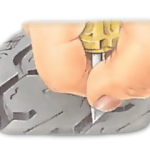
You can make a simple check on tyre-tread depths with an implement such as a small screwdriver, which has a narrow, straight blade that will fit into the grooves between treads or tread blocks; you also need a millimetre rule or measure.
Insert a screwdriver into grooves at right angles to the decorative pattern on the surface, and then use the thumbnail tag on the blade surface height. Be careful not to move your thumb, measure your depth on the scale.
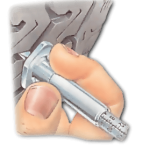
Inexpensive tread-depth gauges are also available, which make checking even easier, and more precise. Make sure that the probe is extended fully, then insert the tip into the groove and press down. The tread depth can be read off on the gauge scale.
Check all round each tyre. Move the car slightly to include the sections of tyre on which the car was standing.
Some tire manufacturing has a built-in warning label, tread depth usually striped across the inside of the groove.
When the tops of the bars become flush with the tread, the tread depth is almost at its legal limit and the tyre should be renewed.
Tyre sizes and markings
Most new tyres are radial-ply tyres. All reputable new radials are marked with the size and speed rating, cross-plies with the size only. Tyres without such markings are best avoided.
Generally, the size of the tire has two tags – the width and the diameter of the rim of the tire. Sizes in inches or mm or a mixture of both is given; Size the unit is inch is cross tyre.
A tyre marked 6.40-10, for example, is 6.4 in. wide on a 10 in. diameter wheel, one marked 135-355 is 135 mm wide on a 355 mm wheel, and one marked 165-15 is 165 mm wide on a 15 in. wheel.
Letters interposed between the sizes are speed ratings, for example 155SR10. For radial-ply tyres speed ratings are: SR up to 113 mph, HR up to 130mph, and VR over 130mph.
In new tires with EEC approval mark, there is only one letter insert – R for radial – letters are separated and speed level.
A number beside it, such as 155R10 76 S, is the load index for the maximum tyre load in kilograms; 76, for example, indicates a 400 kg load.
Low-profile tyres also show the aspect ratio – the percentage of depth to width. For example, 145/70 SR10 means that the tyre depth is 70 per cent of the width.
